Welcome to Roger Russell's
Micro-Acoustics Corporation
History Page
This material is copyrighted
No portion of this site may be reproduced in whole or in part
without written permission of the author.
|
I have limited information on Micro-Acoustics and welcome additions or corrections to expand this page. |
|
![]()
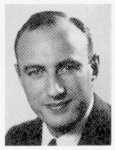 Micro-Acoustics Corporation was located at 8 Westchester
Plaza in Elmsford, NY. Arnold Schwartz, pictured at the left, and Sanford (Sandy)
Drelinger were founders of the company. They ran it jointly under the
stockholders agreement as equal 50/50 owners. Arnold was president and Sandy was vice
president. Arnold had left Sonotone in early 1959 and joined CBS
laboratory where he worked on stereophonic disc recording research requiring
psychoacoustic studies in sound localization and the importance of source
symmetry, ceramic microphone development and non-linear circuitry. He had also
been associated with the Bendix Corporation and University Loudspeakers. He was
awarded a B. S. degree by City College of New York. He was a member of the Institute of Electrical and
Electronics Engineers, The Acoustical Society of America and the Audio
Engineering Society.
Micro-Acoustics Corporation was located at 8 Westchester
Plaza in Elmsford, NY. Arnold Schwartz, pictured at the left, and Sanford (Sandy)
Drelinger were founders of the company. They ran it jointly under the
stockholders agreement as equal 50/50 owners. Arnold was president and Sandy was vice
president. Arnold had left Sonotone in early 1959 and joined CBS
laboratory where he worked on stereophonic disc recording research requiring
psychoacoustic studies in sound localization and the importance of source
symmetry, ceramic microphone development and non-linear circuitry. He had also
been associated with the Bendix Corporation and University Loudspeakers. He was
awarded a B. S. degree by City College of New York. He was a member of the Institute of Electrical and
Electronics Engineers, The Acoustical Society of America and the Audio
Engineering Society.
Sandy Drelinger had an engineering, music and marketing background. He shared responsibility for virtually everything in the company. For the past 25 years, he has been a musical instrument designer and builder specializing in flute mouthpieces.
Micro-Point was founded in 1966 by Arnold Schwartz to manufacture a micro-stylus used to cut the grooves in phonograph records. After he passed away in March of 1983, his son, Edward, ran the company for a while. Edward had written software to automate the manufacturing and testing of the styli. As the record business declined, that portion of Micro-Point was sold in the late 1980’s. However, the company continued as a computer service organization and offered software for testing audio equipment using the GPIB interface. During the 1990’s Micro-Point developed into a full service company and could develop complete solutions for clients.
Sidney Freed was also hired to manage finances.
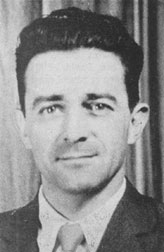 Later, Norman Dieter, Jr. joined Micro-Acoustics as a
junior partner. Norman was previously employed at the Sonotone Corporation
as Section Head in Audio Products. This included research and development of
phonograph cartridges and tape heads. Arnold Schwartz worked for him when he was
at Sonotone. Norman was also my supervisor when I first started working
at Sonotone in 1959. I found Norman to be a very pleasant person to work for and he
always found time for a laugh. He seemed to enjoy his work very much. I recall
his telling me about his efforts to restore a British car called a Hillman
Minx. In 1961, he accepted the position of General Manager at the Tetrad
Company, Inc. in Nyack, NY, a leading manufacturer of diamond and sapphire
phonograph styli.
Later, Norman Dieter, Jr. joined Micro-Acoustics as a
junior partner. Norman was previously employed at the Sonotone Corporation
as Section Head in Audio Products. This included research and development of
phonograph cartridges and tape heads. Arnold Schwartz worked for him when he was
at Sonotone. Norman was also my supervisor when I first started working
at Sonotone in 1959. I found Norman to be a very pleasant person to work for and he
always found time for a laugh. He seemed to enjoy his work very much. I recall
his telling me about his efforts to restore a British car called a Hillman
Minx. In 1961, he accepted the position of General Manager at the Tetrad
Company, Inc. in Nyack, NY, a leading manufacturer of diamond and sapphire
phonograph styli.
I was surprised and sorry to see him leave Sonotone but I think he could not refuse the promising offer from Tetrad. I remember the Tetrad room at the NY Hi-Fi show in the Hotel New Yorker. That was back in 1955, before Norman was there. They were using the best sounding speaker at the show, a unique British Lowther driver system based on the design of Paul Voigt and sold in the USA by Victor Brociner at that time.
Norman passed away on August 8th, 2005. He was extremely close with his wife Shirley Dieter, and daughter Sharon, her husband Peter, grandchildren, Michael, Meghan and Krista Coppola. He was born in White Plains, NY on February 18, 1926. He resided in Pleasantville, NY for 72 years and retired to Brielle, NJ in 1998. Norman was a graduate of Pleasantville schools and received his B.S. and masters degree in Electrical Engineering, Magna Cum Laude from New York University School of Engineering and was licensed to practice professional engineering in New York State. He belonged to Beta Kappa Nu and Alpha Phi Gamma fraternities was also a member of the IEEE. He holds several patents for stereo phonograph cartridges. He was a member of St. Johns Episcopal Church, Pleasantville, NY and served on the vestry board. He also served in the Army Air Forces during World War II, spending six months in Japan.
By 1983, there were 9 different ceramic cartridges and two different magnetic cartridges listed from Micro-Acoustics. 1984 was the last year that Micro-Acoustics was written up in the popular audio magazines. The company had grown to as many as 80 employees by 1980. However, the compact disc was becoming more popular and may have been responsible for the later decline in cartridge sales. Micro-Acoustics then moved to a much smaller facility at 99 Castleton Street, Pleasantville, NY 10570. The 8 Westchester Plaza offices are now occupied by Mamiya America, a well-known Japanese camera manufacturer.
![]()
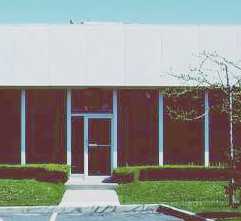 I took this picture of the entrance to
Micro-Acoustics in May of 1979. The Sonotone Corporation was just a
couple of miles south of Micro-Acoustics.
I took this picture of the entrance to
Micro-Acoustics in May of 1979. The Sonotone Corporation was just a
couple of miles south of Micro-Acoustics.
The ceramic cartridge continued to evolve beyond what had been accomplished at Sonotone. The Micro-Acoustics cartridges had a different construction than Sonotone. The stylus arm was directly connected to the ceramic elements, an idea that was patented by Micro-Acoustics. The transducer elements were referred to as electrets, but were made of the same piezoelectric material, lead-zirconium titanate. The ceramic elements had resonance way above 20kHz to insure good response and separation to beyond 20kHz. The cartridges also had an internal microcircuit to convert the amplitude response of the piezo material to velocity equalization for use in a magnetic phono input on a preamplifier. This was electrically similar circuit to the Sonotone Velocitone adapters. The adapters were about 1-1/2” long and plugged into the magnetic phono input of the preamplifier. The back of the adapter accepted the phono plugs.
Here is a cutaway view of the Model 2002-e.
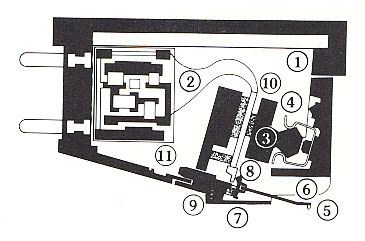
1. Low Mass The low cartridge weight of 4.0 grams is possible
because of the lightweight electret transducer. Low mass allows the
cartridge-tone arm system to track warped and eccentric records without warp or
flutter.
2. Pure-gold connecting wires For reliability and low loss.
3. Mechanical Dampers The cartridge mechanical system is precisely
controlled by a configuration of 8 damping blocks (only 3 show in this view).
This critical damping system achieves optimum transient response, while
allowing the 2002-e to track the heaviest groove modulations at 1 gram or less.
4. Retainer spring Assures precise, positive positioning when the stylus
assembly is inserted into the cartridge body.
5. Elliptical diamond stylus Our playback stylus is shaped and polished
with the same care as our world-famous Micro-Point recording styli.
6. Beryllium stylus bar Beryllium is the ideal stylus –bar material. It
is 35% lighter (lower in mass) than aluminum. By reducing the mass of the
moving system, high-frequency transient and tracking ability are significantly
improved.
7. Dual bearings and resolver For optimum tracking ability and precise
signal resolution. The resolver separates the complex stylus vibrations into
left and right channels. A “perfect” pivot, it is balanced by two elastometric
bearings (only one shown in this view).
8 Direct coupling of stylus bar to electret Coupling the stylus bar to
the electrets at this point directly transmits the undulations of the groove to
the transducers. This unique method of lossless coupling provides virtually
perfect transient ability.
9. User-replaceable stylus assembly
10. Electret transducer A permanently polarized dielectric device best
described as a low-mass electrostatic equivalent of a magnet. It provides
superior response because of inherent linearity from 5Hz to 50kHz.
11. Microcircuit Passive circuit matches the electrical transducer’s
characteristics to preamplifier phono inputs within 1%. Also makes cartridge
output purely resistive
Micro-Acoustics also supplied the Micro-Point cutting stylus to a large part of the recording industry. Several of the Micro-Acoustics cartridges were supplied with the "Micro-point II" diamond stylus. It was the company's proprietary version of the extended or line-contact stylus shape used by most cartridge manufacturers.
I first became aware of Micro-Acoustics in 1971 when I saw an advertisement for the MS-1 add-on radial tweeters array. This consisted of a small box that could be placed on top of a speaker system and contained four Peerless cone tweeters facing at different horizontal angles. They sold for $121.00/pair. Later, several full range speaker systems were added. The feature of all the speakers is improved high frequency dispersion by using multiple angled tweeters.
![]()
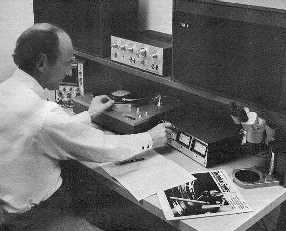 Micro-Acoustics held cartridge-testing clinics in
dealer's showrooms. At the left is a picture from an ad in the June 1979 issue
of Stereo Review showing Arnold Schwartz testing a cartridge. The ad was
advertising the Micro-Acoustics TT-2002 demonstration/test record. On the
record I have, the label is dated 1976. It originally sold postpaid for $3.95
in 1977 but increased to $5.00 in 1979.
Micro-Acoustics held cartridge-testing clinics in
dealer's showrooms. At the left is a picture from an ad in the June 1979 issue
of Stereo Review showing Arnold Schwartz testing a cartridge. The ad was
advertising the Micro-Acoustics TT-2002 demonstration/test record. On the
record I have, the label is dated 1976. It originally sold postpaid for $3.95
in 1977 but increased to $5.00 in 1979.
"The record is specifically designed to test both tracking and transient ability. One side contains a remarkable series of electronic and musical tests, while the other side is pure music, for sheer enjoyment."
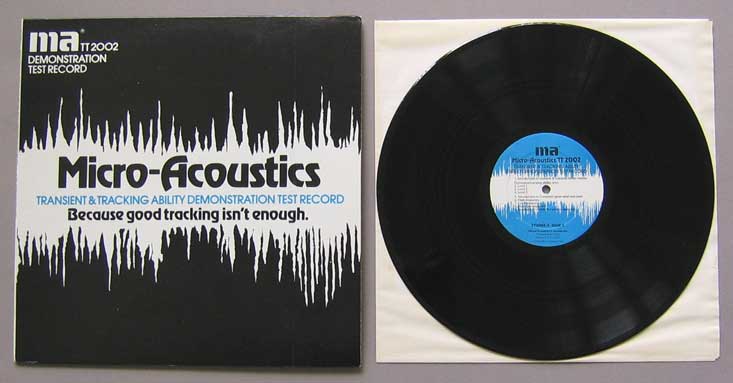
TT2002-A Side 1
Band 1: Introduction to transient & tracking ability testing
Percussion tracking ability tests
Band 2: Level 1
Band 3: Level 2
Band 4: Level 3
Band 5; Introduction to Computer-generated tone tests
Band 6: High-frequency
Band 7: Low-frequency
Band 8: High/low Frequency
Band 8: Introduction to Side B—what to listen for
TT2002-B Side 2
Band 1: Free-R. Lamm ASCAP (Kenton—Creative World Records) 3:22
Band 2: La Creation du Monde (excerpt) Milhaud (Weisberg Nonesuch
Records) 1:30
Band 3: Lover’s Concerto—D. Randel—S. Linzer, Saturday Music, BMI (Perry
& Kingsley–Vanguard Records) 2:11
Band 4: The Typewriter—Leroy Anderson ASCAP (Abravanel—Vanguard Records) 1:48
Band 5: Triumphal March of the Devil Stravinsky—excerpt—L’Histoire Du
Soldat—Stokowski—Vanguard Records) 2:05
Band 6: I Can’t Shake Love—(P. Schickele—Vanguard Records) 1:36
Band 7: Sandpaper Ballet—Leroy Anderson—ASCAP (Abravanel—Vanguard Records) 3:40
![]()
Cartridges
The QDC was the first phono cartridge for Micro-Acoustics. Later, the 2002e and 530mp were introduced. Finally, the 282e was added, replacing the QDC altogether.
In 1980, the “Series II” line of phono cartridges was introduced. The models were 100e, 383, 3002 and 630mp. The series II line used the same basic design on the inside with the same electrets and output load circuit but it was the housing that was completely redesigned. The new housing consisted of a carbon fiber inner frame with abs plastic covers. This reduced the weight so dramatically that a “Variable Weight” system was developed that allowed the user to tailor the weight of the cartridge to the individual tone arm. The 309 model was added to the line in 1981.
The list of products and dates below were taken from magazine advertisements, articles and the annual directories of Audio magazine. There may be some errors in the listings as I have found a few conflicts in the information from year to year.
Thanks to the assistant manager of cartridge production 1975 to 1981.
|
Cartridge |
Specifications |
|
830CSA |
Response 10Hz -30kHz +/- 0.75dB, Output 3.5mV, Tracking 0.75 to 1.25 grams, load capacity 25-1500pf, stylus 0.15 X 1.5 mils, $335 |
|
630MP |
Response 10Hz -30kHz +/- 1.0dB, Output 3.5mV, Tracking 0.75 to 1.25 grams, load capacity 25-1500pf, stylus 0.2 X 1.2 mils, $265 |
|
530MP |
Response 5Hz -20kHz +/- 1.25dB, Output 3.5mV, Tracking 0.7 to 1.4 grams, load capacity NA, stylus Micro Point, $220 |
|
3002 |
Response 10Hz -30kHz +/- 1.5dB, Output 3.5mV, Tracking 0.75 to 1.25 grams, load capacity 25-1500pf, stylus 0.2 X 0.7 mils, $170 |
|
2002E |
Response 5Hz -20kHz +/- 1.5dB, Output 3.5mV, Tracking 0.7 to 1.4 grams, load capacity NA, stylus 0.2 X 0.7 mils, $130 |
|
382 |
Response 10Hz -25kHz +/- 1.5dB, Output 3.5mV, Tracking 0.75 to 1.25 grams, load capacity 25-1500pf, stylus 0.2 X 0.7 mils, $140 |
|
309 |
Response 10Hz -20kHz +/- 1.5dB, Output 3.5mV, Tracking 1.0 to 1.5 grams, load capacity 25-1500pf, stylus 0.2 X 0.7 mils, $120 |
|
282E |
Response 5Hz -20kHz +/- 1.0dB, Output 3.5mV, Tracking 0.75 to 1.4 grams, load capacity NA, stylus 0.2 X 0.7 mils, $100 |
|
100E |
Response 10Hz -20kHz +/- 2.0dB, Output 3.5mV, Tracking 1.0 to 1.5 grams, load capacity 25-1500pf, stylus 0.2 X 0.7 mils, $99 |
|
QDC-1E |
Response 5Hz -20kHz +/- 2.0dB, Output 3.5mV, Tracking 0.75 to 1.5 grams, stylus 0.2 X 0.7 mils, $110 |
|
QDC-1G |
Response 5Hz -50kHz +/- 3.0dB, Output 3.0mV, Tracking 0.75 to 1.5 grams, stylus 0.2 X 0.7 mils Quadrapoint for CD-4 4-channel, $120 |
|
Stratus I |
Response 10Hz -20kHz +/- 1.5dB, Output 3.5mV, Tracking 0.75 to 1.25 grams, load capacity 25-1500pf, stylus 0.2 X 0.7 mils, $200 |
|
Stratus II |
Response 10Hz -20kHz +/- 1.5dB, Output 3.5mV, Tracking 1.0 to 1.5 grams, load capacity 25-1500pf, stylus 0.2 X 0.7 mils, $150 |
|
Stratus III |
Response 10Hz -20kHz +/- 2.0dB, Output 3.5mV, Tracking 1.0 to 1.5 grams, load capacity 25-1500pf, stylus 0.2 X 0.7 mils, $115 |
|
50-PE |
Response 10Hz -20kHz +/- 3.0dB, Output 3.5mV, Tracking 1.0 to 1.5 grams, load capacity 375-500pf, stylus 0.25 X 0.7 mils, $75 |
|
25-PS |
Response 10Hz -20kHz +/- 3.00dB, Output 3.5mV, Tracking 1.0 to 1.5 grams, load capacity 375-500pf, stylus 0.5 mils, $45 |
![]()
The FRM-1 always came with a 5-tweeter array. The first generation FRM-1 used Peerless tweeters. By 1985, Matsushita tweeters were being used, which were finally replaced with four Onkyo tweeters and one Matsushita in the middle position. The actual array bracket on both FRM-1 and 2 were painted glossy black in 1975, unlike the first generation which were a gray gunmetal color. For the “A” series in 1977, the brackets were molded, in-house, from ABS plastic.
The FRM-1 and 2 both used exactly the same cabinet. The only difference being the FRM-1 had two tweeter controls on the rear panel, whereas the FRM-2 had only one control. The cabinet construction was press board covered with a walnut wood-grained vinyl. The original FRM-1 had wood veneer. About 1977, a rosewood shade was introduced and a new grille color was added to the FRM-1 line. The FRM-1s were shipped less grille and the customer could choose the color at the time of purchase. The color choices were black, brown, blue, burnt orange and the newly introduced sandalwood. However, the FRM-2s were shipped with brown grilles.
The FRM-3 was introduced about 1976 or 1977. It used a 8” woofer in a ported cabinet with a 1-3/4” Matsushita tweeter mounted on a rotating plastic “lollipop.”
The list of products and dates below were taken from magazine advertisements, articles and the annual directories of Audio magazine. There may be some errors in the listings as I have found a few conflicts in the information from year to year.
|
MS-1 |
High frequency array, four 1-1/4" cone tweeters, Response 3.5 -30kHz, crossover 3.5/7kHz, Impedance 16 ohms, Size 4" X 9" X 5", Oiled walnut, Beige cloth, 2 lbs, $140/pair |
|
FRM-1 |
10" acoustic suspension, five cone tweeters (three 1-1/4"and two 1-3/4"), response 35-18kHz, Crossover 1.7kHz, Impedance 8 ohms, Size 25-1/2" X 15" X 12-1/2", vinyl walnut, 39 lbs, $149.00 |
|
FRM-2 |
10" acoustic suspension, three 1-1/4" cone tweeters, response 40-16kHz, Crossover 1.7kHz, Impedance 8 ohms, Size 25-3/4" X 15-3/8" X12-1/4", vinyl walnut, brown grille cloth, 32-1/2 lbs, $129.00 |
|
FRM-3 |
8" vented, cone tweeter, response 45-15kHz, Crossover 2.5kHz, Impedance 8 ohms, Size 13" X 22" X 9-1/2", vinyl walnut, brown grille foam, 26 lbs, $127.00 |
|
FRM-1A |
10" acoustic suspension, five 1-1/4"" cone tweeters, response 30-18kHz, Crossover 1.7kHz, Impedance 8 ohms, Size 26" X 15-1/2" X13", vinyl walnut, brown grille cloth, 40 lbs, $210.00 |
|
FRM-2A |
10" acoustic suspension, three 1-1/2" cone tweeters, response 40-16kHz, Crossover 1.75kHz, Impedance 8 ohms, Size 26" X 15-1/2" X12-1/4", vinyl walnut, brown grille foam, 34 lbs, $166.00 |
|
FRM-1ax |
10" acoustic suspension, five 1-1/2" cone tweeters, response 30-22kHz, Sensitivity 89dB, Crossovers 1.5 and 2kHz, Impedance 8 ohms, Size 26-3/4" X 15-1/2" X13", vinyl walnut, brown grille cloth, 40 lbs, $520.00/pair |
|
FRM-2ax |
10" acoustic suspension, two 1-1/2" cone tweeters, response 30-20kHz, Sensitivity 89dB, Crossover 1.8kHz, Impedance 8 ohms, Size 26" X 15-1/2" X13", vinyl walnut, brown grille foam, 38 lbs, $398.00/pair |
|
FRM-3ax |
8" acoustic suspension, two cone tweeters, response 33-20kHz, Sensitivity 91dB, Crossover 2.5kHz, Impedance 8 ohms, Size 22" X 13" X10", vinyl walnut, brown grille foam, 24 lbs, $299.00/pair |
|
1 dx |
10" acoustic suspension, four 1-1/2" cone tweeters, response 30-22kHz, Sensitivity 89dB, Crossovers 1.25 and 2kHz, Impedance 8/4.5 ohms, Size 25-3/4" X 15-3/8" X12-3/4", vinyl walnut, brown grille cloth, 32-1/2 lbs, $286.95 |
|
2 dx |
10" acoustic suspension, two 1-1/2" cone tweeters, response 30-20kHz, Sensitivity 89dB, Crossover 1.8kHz, Impedance 8/6 ohms, Size 25-3/4" X 15-3/8" X12-3/4", vinyl walnut, brown grille cloth, 32-1/2 lbs, $219.95 |
|
3 dx |
8" vented, two cone tweeters, response 33-20kHz, Sensitivity 91dB, Crossover 2.5kHz, Impedance 8/6.5 ohms, Size 12-5/8" X 22" X 9-5/8", vinyl walnut, brown grille foam, 25 lbs, $164.95 |
![]()
Transient Response and Intermodulation Studies in Phonograph reproduction by Benjamin B. Bauer, Arnold Schwartz and Arthur J. Gust. Presented at the 14th AES Convention in October 1962. It describes the development of the CBS STR-111 and STR-120 test records.
Absolute Calibration of Pickups and Records by Arnold Schwartz, A.J. Gust and B. B. Bauer. Presented in October 1965 at the 17th AES Convention. It describes the development of the CBS STR-130 test record.
The Phono Cartridge Electrical Output Network by Arnold Schwartz. Audio March 1981 Page 26 [4 pages]
A New High Quality Electret Phonograph Pickup Presented in 1976 by Norman Dieter, Jr. at the 55th AES Convention. It describes the Micro-Acoustics MA2002e cartridge.
![]()
Reviews
Review copies are
available
Microstatic High-Frequency Adapter. Stereo Review June 1971. Page 34 [3 pages]
Micro/Acoustics FRM-1 Speaker System. Stereo Review May 1973. Page 42 [2 pages]
The Microstatic Full-Range Loudspeaker. Audio June 1973. Page 60 [2 pages]
Microstatic MS-1 Add-On Speaker. Audio July 1973 Page 56 [1 page]
Micro-Acoustics QDC-1e Phono Cartridge. Stereo review April 1975 page 32 [3 pages]
Micro-Acoustics QDC-1e Phono Cartridge. Audio January 1976 page 56 [2 pages]
Micro-Acoustics 2002-e Phono Cartridge. Stereo Review December 1976 [3 pages]
Micro-Acoustics 3002 Phono Cartridge Stereo Review December 1980 page 40 [3 pages]
Top Pickup from Micro-Acoustics High Fidelity May 1981 page 24 [2 pages]
Micro-Acoustics 630 Phono Cartridge. Audio March 1984 Page 67 [3 pages]
M-A's Micro Cartridge High Fidelity January 1985 Page 32 [1 page]
![]()
|
April 20, 1976 |
3,952,171 |
Norman H. Dieter, Jr. |
Phonograph Pickups. |
|
March 16, 1982 |
4,320,492 |
Norman H. Dieter, Jr. |
Variable Weight Phonograph Cartridge |
|
April 20, 1982 |
4,326,285 |
Norman H. Dieter, Jr. |
Stereo Phonograph Cartridge |
|
June 8, 1982 |
D264,816 |
Sanford Drelinger |
Phonograph Cartridge Box |
![]()
|
About This Site |
||
|
|
More text and pictures about Micro-Acoustics will be added as my research continues. Any comments, corrections, or additions are welcome. |
|
|
|
Created
by Roger Russell |
|